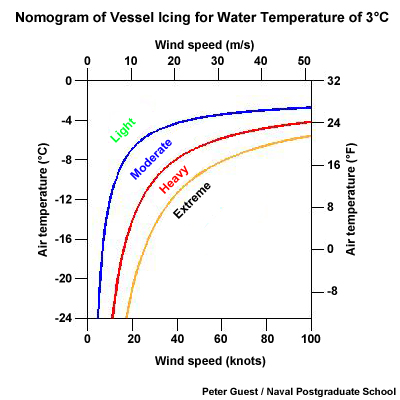Vessel IcingQuestions
Question 1
Which of the following factors increase icing? (Choose all that apply.)
The correct answers are a) "decreasing air temperature," c) "distance <200 km from shore," and d) "increasing wave height all increasing icing potential."
Decreasing air temperature cools spray. With enough cooling it will freeze on contact with the ship. Increasing wind speed and wave height both increase the amount of spray in the air. A ship travelling into the wind will generate more spray, too. Cold offshore winds gradually warm from contact with warmer water. Winds that travel more than 200 km offshore have typically warmed enough that icing does not present a problem.
Question 2
For ships 20-75 meters in length, an ice accumulation of an inch per hour would be classified as which of the following? (Choose the best answer.)
The correct answer is c) "Heavy."
The NOAA icing classification is as follows:
| Icing Class Icing Rates |
None | Light | Moderate | Heavy | Extreme |
| (cm/hr) | 0 | <0.7 | 0.7 - 2.0 | 2.0 | >4.0 |
| (in/hr) | 0 | <0.3 | 0.3 - 0.8 | 0.8 -1.6 | >1.6 |
| Overland (1990) | |||||
Question 3

Based on this nomogram, what sort of icing would you expect for the following conditions:
Water temperature = 3°C
Windspeed = 20 kt (10 m/s)
Air temperature = 14°F (-10°C)
(Choose the best answer.)
The correct answer is b) "Moderate."